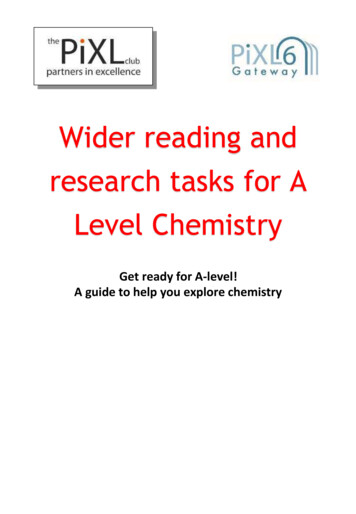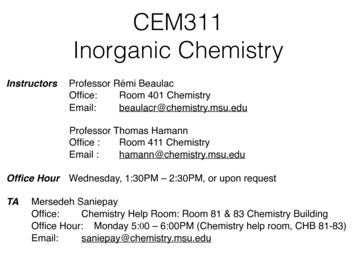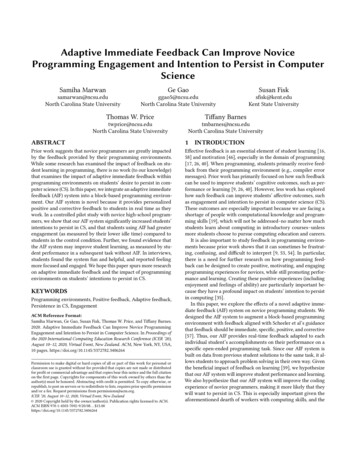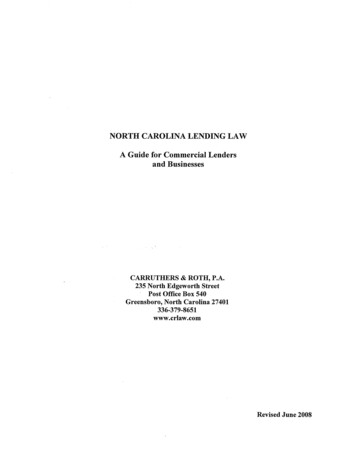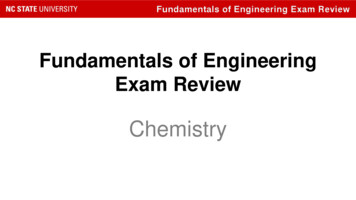
Transcription
Fundamentals of Engineering Exam ReviewFundamentals of EngineeringExam ReviewChemistry
Fundamentals of Engineering Exam ReviewOther Disciplines FE SpecificationsChemistry: 7–11 FE exam problemsA. Periodic Table (e.g., nomenclature, metals and non-metals, atomicstructure of matter)- 8Q’sB. Oxidation and Reduction – 4 Q’sC. Acids and Bases – 5 Q’sD. Equations (e.g., stoichiometry, equilibrium) – 7 Q’sE. Gas Laws (e.g., Boyle’s and Charles’ Laws, molar volume) – 4 Q’s
Fundamentals of Engineering Exam ReviewA. PERIODIC TABLE:NOMENCLATURE, METALS AND NON-METALSThe Periodic Table is divided into three regions:metals, non-metals, and metalloidsMaterials composed of all the same type of metal or non-metal aresimply named by their element symbol.Proper nomenclature requires identifying if a compound iscomposed of:metals & non-metals (ionic)non-metals & non-metals (molecular)A. Periodic Table3
Fundamentals of Engineering Exam Reviewmetalsmetalloidsnon-metals(Periodic Table from chemistry section of FE Reference Handbook)A. Periodic Table4
Fundamentals of Engineering Exam ReviewIonic compounds are composed of metals and non-metalsIf the metal is from periodic table column I, column II, or aluminium,name of the compound with the metal name and the non-metal namewith a substituted -IDE endingCaCl2 is calcium chlorIDE (chlorine chloride)Na2O is sodium oxIDE (oxygen oxide)Al2S3 is aluminium sulfIDE (sulfur sulfide)A. Periodic Table5
Fundamentals of Engineering Exam ReviewIonic compounds are composed of metals and non-metalsIf the metal is NOT FROM periodic table column 1, column 2, oraluminium, name of the compound with the metal name (romanmumber representing charge) and the non-metal name with asubstituted -IDE endingFeCl2 is iron (II) chloride (each Cl is -1 so Fe is 2)TiO2 is titanium (IV) oxide (each O is -2 so Ti is 4)Tl2S3 is thallium (III) sulfide (each S is -2 so Tl is 3)A. Periodic Table6
Fundamentals of Engineering Exam ReviewIonic compounds are also composed of metals orammonium and polyatomic ions, show below.A. Periodic TableCationsNH41 -ammonium ionH3O1 hydronium ionacetate ioncarbonate ionperchlorate ionchlorate ionchlorite ionhypochlorite ionchromate iondichromate ioncyanide ionOH1NO31NO21MnO41O22PO43SO42SO32-hydroxide ionnitrate ionnitrite ionpermanganate ionperoxide ionphosphate ionsulfate ionsulfite ion7
Fundamentals of Engineering Exam ReviewPolyatomics are used in the ionic name without change.NaOH is sodium hydroxide, and Fe(OH)3 is iron (III) hydroxideCaSO4 is calcium sulfate, and CuSO4 is copper(II) sulfateNH4Cl is ammonium chloride, and (NH4)3PO4 is ammonium phosphateA. Periodic Table8
Fundamentals of Engineering Exam ReviewMolecular compounds are composed of non-metalsThe non-metal on the left of the period table is named as-is and thenon-metal or the right of period table is name with a substituted -IDEending.Greek prefixes are used to indicate how many of each atom type ispresent.A. Periodic Table# atomsPrefix# 5penta10deca9
Fundamentals of Engineering Exam ReviewMolecular compounds are composed of non-metalsGreek prefixes are used for all atoms in a molecular compound,except when there is only one of the first atom typeN2O3 is dinitrogen trioxideN2O is dinitrogen monoxideNO2 is nitrogen dioxideA. Periodic Table10
Fundamentals of Engineering Exam ReviewChem A1: Identify the name of Mg(OH)2A) Magnesium (II) hydroxideB) Magnesium dihydroxideC) Magnesium hydroxideD) Magnesium epoxideA. Periodic Table11
Fundamentals of Engineering Exam ReviewChem A2: Identify the name of MnCO3A) Manganese carbideB) Manganese (II) carbonateC) Manganese (I) carbonateD) Manganese carbonateA. Periodic Table12
Fundamentals of Engineering Exam ReviewChem A3: Which material is platinum (IV) bromide?A) Pt4BrB) PtBr2C) PtBr3D) PtBr4A. Periodic Table13
Fundamentals of Engineering Exam ReviewChem A4: Identify the name of SO3A) Monosulfur trioxideB) Sulfur (VI) oxideC) Sulfur trioxideD) Sulfur trioxygenA. Periodic Table14
Fundamentals of Engineering Exam ReviewChem A5: Which material is dichlorine heptoxide?A) Cl2O7B) Cl3O6C) ClO7D) Cl4O7A. Periodic Table15
Fundamentals of Engineering Exam ReviewA. PERIODIC TABLE: ATOMIC STRUCTURE OF MATTER# of protons defines theelement: known asatomic number# of protons andneutrons gives theatomic mass# of protons minus the# of electrons gives thechargeA. Periodic TableMajor Subatomic ParticlesParticleElectron (e-)Proton (p )Neutron (n0)Mass (amu) Charge0.00051.00781.0087-1 1016
Fundamentals of Engineering Exam ReviewA. PERIODIC TABLE: ATOMIC STRUCTURE OF MATTERFor example, iron (Fe) has an atomic mass as 56 for themost common isotope, and 3 as the most common charge.How many protons, neutrons and electrons are in 56Fe3 ?The periodic table provides thenumber of protons: 26The atomic mass - #protons givesthe neutrons: 56 – 26 30A. Periodic Table26Fe55.84717
Fundamentals of Engineering Exam ReviewA. PERIODIC TABLE: ATOMIC STRUCTURE OF MATTERFor example, iron (Fe) has an atomic mass as 56 for themost common isotope, and 3 as the most common charge.How many protons, neutrons and electrons are in 56Fe3 ?Solve the equation to give #electrons:charge #protons - #electrons 3 26- # electrons#electrons 23A. Periodic Table26Fe55.84718
Fundamentals of Engineering Exam ReviewChem A6: The element chlorine has two major isotopes.The atomic nuclei of these isotopes contain how manyprotons?A) 35.453B) 1717C) 6ClD) 27A. Periodic Table35.45319
Fundamentals of Engineering Exam ReviewChem A7: How many protons, neutrons and electrons arein 17O2-?8A) 8 protons, 7.999 neutrons, 10 electronsO15.999B) 17 protons, 9 neutrons, 10 electronsC) 8 protons, 9 neutrons, 10 electronsD) 8 protons, 9 neutrons, 6 electronsA. Periodic Table20
Fundamentals of Engineering Exam ReviewChem A8: What is the correct notation for an ion that has19 protons, 21 neutrons and 18 electrons?819A)40K1 B)39K1 C)40K1-D)19F1-A. Periodic TableF19.998K39.09821
Fundamentals of Engineering Exam ReviewB. OXIDATION AND REDUCTIONKnowledge of oxidation states is required to answer questions concerningoxidation and reduction. Below are some reminders.1.The oxidation state of an element is 0. Elements are represented as asingle atomic symbol (Cr) or molecule composed of one element type (P4)2.Fluorine (F) in a compound has a -1 oxidation state. So NaF has F-1.(F2 is an element and the F is oxidation state 0.)3. For compounds,metals in column I have a 1 oxidation state (NaCl Na1 )metals in column I have a 1 oxidation state (CaS Ca2 )aluminium has a 3 oxidation state (Al2O3 Al3 )B. Oxidation and Reduction22
Fundamentals of Engineering Exam ReviewB. OXIDATION AND REDUCTION4. Hydrogen is unusual. It is 1 when bonded to non-metals (NH3 H 1)and -1 when bonded to metals (NaH H-1)5. Oxygen(O) in a compound has a -2 oxidation state. So K2O has O-2.(O2 is an element and the O is oxidation state 0.)6. Group VII atoms in compounds have a -1 charge. So CrCl3 Cl-1The oxidation state of other elements in a compound can be determinedalgebraically.In V2O3, O has -2 oxidation state. The entire compound has 0 charge.Therefor 2 x (V ox state) (3 x -2) 0. V must be 3 oxidation state.In NH41 , H has 1 oxidation state. The entire compound has 1 charge.Therefor 1 x (N ox state) (4 x 1) 1. N must be -3 oxidation state.B. Oxidation and Reduction23
Fundamentals of Engineering Exam ReviewB. Oxidation and ReductionRelating oxidation states to the period table will allow easier memorization 1 2 1 2 1 2 1 2 1 2 1 or 3-4 -3 -2 -1-3 -2 -1 3-2 -1 2 or 3-1maybe 1, 4, 5, 6 7 1 or 3B. Oxidation and Reduction 2 or 424
Fundamentals of Engineering Exam ReviewB. OXIDATION AND REDUCTIONOxidation occurs when an atom loses electrons andbecomes more positive in oxidation state.Reduction occurs occurs when an atom gains electrons andbecomes more negative in oxidation state.In a Redox reaction, both reduction and oxidation occur.Fe Cu2 Fe2 CuOxidation: Fe changes from oxidation state 0 in reactant to 2 in product.(oxidation state becomes more positive)Reduction: Cu changes from oxidation state 2 in reactant to 0 in product.(oxidation state becomes more negative)B. Oxidation and Reduction25
Fundamentals of Engineering Exam ReviewChem B1: Which chemical change below represents theoxidation of nitrogen?A) N2 NH3C) N2O NO3-B) NO N2O2D) NF3 NO2-B. Oxidation and Reduction26
Fundamentals of Engineering Exam ReviewChem B2: Which chemical change below represents thereduction of carbon?A) CH4 CO2C) C2Cl4 COB) CO2 COD) C C2H2Cl2B. Oxidation and Reduction27
Fundamentals of Engineering Exam ReviewChem B3: Which chemical change below is not areduction-oxidation reaction?A) 2K I2 2 KIC) 4 Fe 3 O2 2Fe2O3B) SnO2 C Sn CO2D) Ca2 2 Cl1- CaCl2B. Oxidation and Reduction28
Fundamentals of Engineering Exam ReviewChem B4: Which chemical change below is not areduction-oxidation reaction?A) CH4 2O2 CO2 2 H2OC) Pb PbO2 4H 2Pb2 2 H2OB) Ag2S 2Cl- 2AgCl S2-D) Mg H2O H2 MgOB. Oxidation and Reduction29
Fundamentals of Engineering Exam ReviewC. ACIDS AND BASESAcids are compounds that when added to water donate a H ion to form H3O .HCl H2O Cl- H3O Typically the number of H atoms in the front of a chemicalformula are the acidic hydrogens and provide the valencechange.HC2H3O2 has 1 acidic H (valence change 1)H2S has 2 acidic H’s (valence change 2)H3PO4 has 3 acidic H’s (valence change 3)C. Acids and Bases30
Fundamentals of Engineering Exam ReviewC. ACIDS AND BASESBases are compounds that when added to water remove aH from water to form OH-.NH3 H2O NH4 OHMost bases are negatively charged and exist as ionic compoundsin the solid form. Bases can accept multiple H ionsNaOH (OH- in water) accepts one H (valence change 1)Na2CO3 (CO32- in water) accepts two H (valence change 2)Li3PO4 (PO43- in water) accepts three H (valence change 3)C. Acids and Bases31
Fundamentals of Engineering Exam ReviewC. ACIDS AND BASESAcids and Bases can react to form water and an ionic salt ina neutralization reaction.HCl NaOH NaCl H2OThe stoichiometry of the reaction can vary depending on thematerials:H2S 2 NaOH Na2S 2H2OThe reaction above requires twice as many moles of NaOH asH2S, because H2S has two H to donate (valence change 2), andOH- can only accept one H (valence change 1)C. Acids and Bases32
Fundamentals of Engineering Exam ReviewC. ACIDS AND BASESConcentration expressed in units of molarity or normality:Molarity of Solutions – The number of gram moles of asubstance dissolved in a liter of solution.Normality of Solutions – The product of the molarity of asolution and the number of valence changes taking place ina reaction(formula from chemistry section of FE Reference Handbook)For example, 18.23 g of HCl in 1.00 liter (L) of water wouldbe 0.500 Molarity (M) and 0.500 Normality (N).Molar mass of HCl is (1.0079 35.453 36.4609 g HCl/mol)18.25 g HCl x (1 mol HCl / 36.4609) / 1.00 L 0.500 MAs HCl can only donate 1 H , it is also 0.500 NC. Acids and Bases33
Fundamentals of Engineering Exam ReviewChem C1: What is the Molarity of 10.00 grams of HF dissolved in 2.00liters of water? The atomic weights of H and F are 1 and 19, respectively.A) 0.125 MB) 0.250 MC) 0.500 MD) 1.00 MMolarity of Solutions – The number of gram moles of asubstance dissolved in a liter of solution.C. Acids and Bases34
Fundamentals of Engineering Exam ReviewChem C2: What is the Normality of 6.80 grams of H2S dissolved in 1.00 literof water? The atomic weights of H and S are 1 and 32, respectively.A) 1.00 NB) 0.400 NC) 0.200 ND) 0.100 NMolarity of Solutions – The number of gram moles of asubstance dissolved in a liter of solution.Normality of Solutions – The product of the molarity of asolution and the number of valence changes taking place ina reactionC. Acids and Bases35
Fundamentals of Engineering Exam ReviewChem C3: The atomic weights of sodium, oxygen and hydrogen are 23, 16and 1, respectively. To neutralize 8 g of NaOH dissolved in 1 L of waterrequires 1 L of A)B)C)D)0.0500 normal HF solution0.100 normal HF solution0.200 normal HF solution0.800 normal HF solutionC. Acids and BasesMolarity of Solutions – The number of gram moles of asubstance dissolved in a liter of solution.Normality of Solutions – The product of the molarity of asolution and the number of valence changes taking place ina reaction36
Fundamentals of Engineering Exam ReviewChem C4: The atomic weights of sodium, oxygen and hydrogen are 23, 16and 1, respectively. To neutralize 4 g of NaOH dissolved in 1 L of waterrequires 1 L of Molarity of Solutions – The number of gram moles of aA) 0.0500 normal H2S solution substance dissolved in a liter of solution.B) 0.100 normal H2S solution Normality of Solutions – The product of the molarity of aC) 0.200 normal H2S solution solution and the number of valence changes taking place ina reactionD) 0.800 normal H2S solutionC. Acids and Bases37
Fundamentals of Engineering Exam ReviewChem C5: The atomic weights of sodium, carbon and oxygen are 23, 12and 16, respectively. To neutralize 21.2 g of Na2CO3 dissolved in 1 L ofwater requires 1 L of A)B)C)D)0.100 normal HF solution0.200 normal HF solution0.400 normal HF solution0.800 normal HF solutionC. Acids and BasesMolarity of Solutions – The number of gram moles of asubstance dissolved in a liter of solution.Normality of Solutions – The product of the molarity of asolution and the number of valence changes taking place ina reaction38
Fundamentals of Engineering Exam ReviewD. EQUATIONS: STOICHIOMETRYStep 1: Add one coefficient at a time, starting with most complex compoundStep 2: Add coefficients to the other side of the reaction, based upon yourcoefficient in step 1.Step 3: Go back and forth until all materials have a coefficientStep 4: Check when finished to ensureatoms in atoms outcharge in charge out1- H O1 1 2 H2 2O HCl1Cl OCl11 32 Cl4H2OD. Equations2 Cl4H2O39
Fundamentals of Engineering Exam ReviewChem D1: Match the numbers with the correct blanks in the equation tobalance the reaction. Some numbers may be used more than once, othersnot at all.P4O10 H2O H3PO41D. Equations24681240
Fundamentals of Engineering Exam ReviewChem D2: Match the numbers with the correct blanks in the equation tobalance the reaction. Some numbers may be used more than once, othersnot at all.Ca2 PO43- Ca3(PO4)21D. Equations234541
Fundamentals of Engineering Exam ReviewChem D3: Match the numbers with the correct blanks in the equation tobalance the reaction. Some numbers may be used more than once, othersnot at all.Cr2O72- Fe H1 Cr3 Fe2 H2O1D. Equations23467121442
Fundamentals of Engineering Exam ReviewD. EQUATIONS: STOICHIOMETRYMolecular or Atomic weight is sumof particles relative to 12 grams of12C. This can be determined byadding up the component massesusing the periodic table. (definition from chemistry section of FE Reference Handbook)Formula is the Key – check subscripts for moles of each3x2 6 OCa(NO)HNO23 21 Ca1x2 2 N1H 1N 2O1.0079 14.007 (2x15.999)47.0129 gramsD. Equations40.078 (2x14.007) (6x15.999)164.085 grams43
Fundamentals of Engineering Exam ReviewChem D4: The molecular (or atomic) weight (g/g-mole) of sodiumphosphate (Na3PO4) is most nearly A) 96B) 34C) 70D) 16481115Na PO15.999 22.990 30.974D. Equations44
Fundamentals of Engineering Exam ReviewChem D5: The molecular (or atomic) weight (g/g-mole) of aluminium sulfate(Al2(SO4)3) is most nearly A) 342B) 278C) 426D) 19881316Al SO15.999 26.981 32.066D. Equations45
Fundamentals of Engineering Exam ReviewD. EQUATIONS: EQUILIBRIUMIn general, the equilibrium constant, Keq, is equal toconcentration of products ([C] and [D]) divided by reactants([A] and [B]), raised to their coefficients (a, b, c, d).(formula from chemistry section of FE Reference Handbook)D. Equations46
Fundamentals of Engineering Exam ReviewChem D6: Consider the following equation:K [C]3 [D]2[A] [B]2The equation above is the formulation of the chemical equilibriumconstant equation for which of the following reactions?A) 3C 2D A 2BB) C3 D2 A B2C) A B2 C3 D2D) A 2B 3C 2DD. Equations47
Fundamentals of Engineering Exam ReviewChem D7: Consider the following chemical reaction:2A 3B C 4DWhat is the formula for the equilibrium constant for this reaction?A)C)D. EquationsK K [C] [4D]4[2A] 2[3B]3[A]2 [B]3[C]B)[D]4A)K K [C] [D]4[A] 2 [B]3[2A] [3B][C] [4D]48
Fundamentals of Engineering Exam ReviewE. GAS LAWS: BOYLE’S AND CHARLES LAWP1n1T1 P2n2T2P pressuren specific volumeT absolute temperature in KelvinIn situations where temperature is constant, Boyle’s Law canbe used:P1n1 P2n2In situations where pressure is constant, Charles’ Law can beused:n1 n2 T1E. Gas LawsT2(formula from thermodynamics section of FE Reference Handbook)49
Fundamentals of Engineering Exam ReviewE. GAS LAWS: MOLAR VOLUME(From chemistry section of FE Reference Handbook)Reminder: Kelvin Celsius 273. 15(From thermodynamics section of FE Reference Handbook)E. Gas Laws50
Fundamentals of Engineering Exam ReviewChem E1: The volume (L) of 1 mol of H2O at 348 K and 1.00 atmpressure is most nearly:A) 17.6E. Gas LawsB) 28.5C) 22.4D) 18.751
Fundamentals of Engineering Exam ReviewChem E2: The volume (L) of 1 mol of CH4 at 273.15 K and 2.65 atmpressure is most nearly:A) 12.5E. Gas LawsB) 22.4C) 59.4D) 8.4552
Fundamentals of Engineering Exam ReviewChem E3: The pressure of 25 kg of carbon monoxide (CO) at50 C in a 50-m3 tank is most nearly.A) 13.3 kPaE. Gas LawsB) 48.0 kPaC) 4.39 kPaD) 7.42 kPa53
Fundamentals of Engineering Exam ReviewChem E4: The volume needed for 700 kg of methane (CH4) at40 C and 1.10 atm pressure within a reactor is most nearly .A) 6.46 x 105 L B) 1.03 x 108 L C) 1.02 x 106 L D) 1.02 x 103 LE. Gas Laws54
Fundamentals of Engineering Exam ReviewBest of luck on your FE Exam. I hope you have found thisreview module helpful.Dr. Lori M. PetrovichNC State UniversityDepartment of ChemistryTeaching Associate Professor andDirector of General Chemistry LabsE. Gas Laws55
Chemistry: 7-11 FE exam problems A. Periodic Table (e.g., nomenclature, metals and non-metals, atomic structure of matter)- 8Q's . Fundamentals of Engineering Exam Review 3 Proper nomenclature requires identifying if a compound is composed of: metals & non-metals (ionic)


